70 Nations Unite on 13 October, World Thrombosis Day, to Issue Global Call on Blood Clot Risk Assessment in Hospitals
 CARRBORO, N.C., Oct. 12, 2015 — More than 300 medical societies, government health agencies and advocacy organizations in 70 countries have come together to call on their health systems to require hospital-based risk assessments for venous thromboembolism (VTE), blood clots occurring in the leg and in the lungs. VTE is a leading cause of preventable death in hospitals worldwide – ahead of infection and pneumonia, according to the World Health Organization’s (WHO) Patient-Safety Program.[i]
CARRBORO, N.C., Oct. 12, 2015 — More than 300 medical societies, government health agencies and advocacy organizations in 70 countries have come together to call on their health systems to require hospital-based risk assessments for venous thromboembolism (VTE), blood clots occurring in the leg and in the lungs. VTE is a leading cause of preventable death in hospitals worldwide – ahead of infection and pneumonia, according to the World Health Organization’s (WHO) Patient-Safety Program.[i]
Culminating on 13 October and led by the International Society on Thrombosis and Haemostasis, World Thrombosis Day (WTD) seeks to build awareness of thrombosis, the formation of blood clots and a condition that kills approximately 1 in 4 people around the world.[ii]
- Globally, an estimated 10 million cases of VTE occur annually.[iii]
- In Europe and the United States alone, more than 600,000 people die from VTE every year – more than the combined death toll from prostate and breast cancer, AIDS and motor vehicle crashes.[iv],[v]
Currently, most health systems do not require hospitals to assess incoming patients for their risk of developing VTE, despite the fact that up to 60 percent of all VTE cases are hospital associated.[vi] When enforced, risk assessments have been associated with reductions of VTE-related deaths among hospital patients.[vii]
“A patient going into the hospital is at an increased risk for developing VTE, whether admitted for surgery or medical illness,” said Gary Raskob, Ph.D., dean of the College of Public Health at the University of Oklahoma Health Sciences Center, and chairman of the World Thrombosis Day Steering Committee. “People need to know that hospitalization is a leading risk factor for VTE, and hospitals owe it to their patients to be vigilant about performing VTE risk assessments on every patient. The results of that assessment should be used to decide about the use of evidence-based preventive measures against VTE.”
Only 25 percent of adults around the world think that hospitalization is a risk factor for VTE, according to a nine-nation survey conducted by global polling firm Ipsos for the ISTH and published earlier this year in the Journal of Thrombosis and Haemostasis.[viii] The survey queried 7,233 participants and was the largest international survey of its kind.
In addition to issuing the hospital and health system mandate call-to-action, efforts during WTD will focus on public education and urging people going into the hospital to proactively ask for a VTE risk assessment.
VTE refers collectively to:
- Deep vein thrombosis (DVT), a blood clot that occurs in a deep vein (usually in the leg); and
- Pulmonary embolism (PE), a blood clot that breaks loose and travels to the lungs. This is a life-threatening condition that requires immediate medical care.
It is important for the public to recognize signs and symptoms that might indicate an event.
- DVT or blood clot in the leg: Indicators include pain/tenderness or swelling often starting in the calf; redness, noticeable changes in color and/or warmth in the leg.
- PE or blood clot in the lung: Indicators include unexplained shortness of breath or rapid breathing; chest pain (sometimes worse upon a deep breath); rapid heart rate; and/or light headedness or passing out.
While these indicators do not necessarily mean the presence of VTE, a medical professional should assess them immediately.
Go to WorldThrombosisDay.org to learn more about VTE, the signs and symptoms, key risk factors and how to prevent it. To watch an animated video on VTE, visit https://youtu.be/GfPfqMF03w8.
References:
[i] Jha AK, Larizgoitia I, Audera-Lopez C, Prasopa-Plaizier N, Waters H, Bates DW. The global burden of unsafe medical care: analytic modelling of observational studies. BMJ Qual Saf 2013; 22: 809-15.
[ii] Lozano R, Naghavi M, Foreman K, Lim S, Shibuya K, Aboyans V, Abraham J, Adair T, Aggarwal R, Ahn SY, Alvarado M, Anderson HR, Anderson LM, Andrews KG, Atkinson C, Baddour LM, Barker-Collo S, Bartels DH, Bell ML, Benjamin EJ, et al. Global and regional mortality from 235 causes of death for 20 age groups in 1990 and 2010: a systematic analysis for the Global Burden of Disease Study 2010. Lancet 2012; 380: 2095-128.
[iii] Jha AK, Larizgoitia I, Audera-Lopez C, Prasopa-Plaizier N, Waters H, Bates DW. The global burden of unsafe medical care: analytic modelling of observational studies. BMJ Qual Saf 2013; 22: 809-15.
[iv] Beckman MG, Hooper WC, Critchley SE, Ortel TL. Venous thromboembolism: a public health concern. Am J Prev Med 2010; 38:495-501.
[v] Heit JA. Poster 68 presented at American Society of Hematology, 47th Annual Meeting, Atlanta, GA, December 10-13, 2005.
[vi] Heit JA. The epidemiology of venous thromboembolism in the community. Arterioscler Thromb Vasc Biol 2008; 28: 370-2.
[vii] Catterick D and Hunt BJ. Impact of the national venous thromboembolism risk assessment tool in secondary care in England: retrospective population-based database study. Blood Coagulation and Fibrinolysis 2014; 25: 00-00.
[viii] Wendelboe AM, McCumber M, Hylek EM, Buller H, Weitz JI, Raskob G, for the ISTH Steering Committee for World Thrombosis Day. Global public awareness of venous thromboembolism. J Thromb Haemost 2015; 13: 1365–71.
Read via PR Newswire at http://www.prnewswire.com/news-releases/65-nations-unite-on-13-october-world-thrombosis-day-to-issue-global-call-on-blood-clot-risk-assessment-in-hospitals-300157497.html.
Share this post, choose a platform
Related Campaign News
Get ready for World Thrombosis Day (WTD) 2024 with exciting and [...]
Light Up World Thrombosis Day with a Landmark Illumination Illuminate a [...]
As the world eagerly anticipates the upcoming Olympics in Paris, athletes [...]



